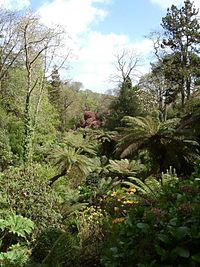- Microclimate
-
For the viticultural use of the term microclimate, see Regional climates levels in viticulture.
 Tree ferns thrive in a protected dell at the Lost Gardens of Heligan, in Cornwall, England, latitude 50° 15'N
Tree ferns thrive in a protected dell at the Lost Gardens of Heligan, in Cornwall, England, latitude 50° 15'N
A microclimate is a local atmospheric zone where the climate differs from the surrounding area. The term may refer to areas as small as a few square feet (for example a garden bed) or as large as many square miles. Microclimates exist, for example, near bodies of water which may cool the local atmosphere, or in heavily urban areas where brick, concrete, and asphalt absorb the sun's energy, heat up, and reradiate that heat to the ambient air: the resulting urban heat island is a kind of microclimate.
Another contributing factor to microclimate is the slope or aspect of an area. South-facing slopes in the Northern Hemisphere and north-facing slopes in the Southern Hemisphere are exposed to more direct sunlight than opposite slopes and are therefore warmer for longer.
The area in a developed industrial park may vary greatly from a wooded park nearby, as natural flora in parks absorb light and heat in leaves, that a building roof or parking lot just radiates back into the air. Advocates of solar energy argue that widespread use of solar collection can mitigate overheating of urban environments by absorbing sunlight and putting it to work instead of heating the foreign surface objects.[citation needed]
A microclimate can offer an opportunity as a small growing region for crops that cannot thrive in the broader area; this concept is often used in permaculture practiced in northern temperate climates. Microclimates can be used to the advantage of gardeners who carefully choose and position their plants. Cities often raise the average temperature by zoning, and a sheltered position can reduce the severity of winter. Roof gardening, however, exposes plants to more extreme temperatures in both summer and winter.
Tall buildings create their own microclimate, both by overshadowing large areas and by channelling strong winds to ground level. Wind effects around tall buildings are assessed as part of a microclimate study.
Microclimates can also refer to purpose made environments, such as those in a room or other enclosure. Microclimates are commonly created and carefully maintained in museum display and storage environments. This can be done using passive methods, such as silica gel, or with active microclimate control devices.
Contents
Cities and Regions Known for Microclimates
San Francisco is a city with microclimates and submicroclimates. Due to the city's varied topography and influence from the prevailing summer marine layer, weather conditions can vary by as much as 9°F (5°C) from block to block.[1]
The region as a whole, known as the San Francisco Bay area can have a wide range of extremes in temperature. In the basins and valleys adjoining the coast, climate is subject to wide variations within short distances as a result of the influence of topography on the circulation of marine air. The San Francisco Bay Area offers many varieties of climate within a few miles. In the Bay Area, for example, the average maximum temperature in July is about 64 °F (18 °C) at Half Moon Bay on the coast, 87 °F (31 °C) at Walnut Creek only 25 miles (40 km) inland, and 95 °F (35 °C) at Tracy, just 50 miles (80 km) inland.[2]
The Los Angeles and San Diego areas are also subject to phenomena-typical of a microclimate. As such, the temperatures can vary as much as 18°F (10°C) between inland areas and the coast, with a temperature gradient of over one degree per mile (1.6 km) from the coast inland. Southern California has also a weather phenomenon called "June Gloom or May Grey", which sometimes gives overcast or foggy skies in the morning at the coast, but usually gives sunny skies by noon, during late spring and early summer.
Calgary, Alberta is also known for its microclimates. Especially notable are the differences between the downtown and river valley/flood plain regions and the areas to the west and north. This is largely due to an elevation difference within the city's boundaries of over 1,000 ft (300 m), but can also be attributed somewhat, to the effects of the seasonal Chinooks.[3]
Halifax, Nova Scotia also has numerous microclimates. Coastal temperatures and weather conditions can differ considerably from areas located just 5–15 km inland. This is true in all seasons. Varying elevations are common throughout the city, and it is even possible to experience several microclimates while travelling on a single highway due to these changing elevations.
Santiago, Chile is also subject to microclimates.
Known for its wines, the Ticino region in Switzerland benefits from a microclimate in which palm trees and banana trees grow.
Gran Canaria is called "Miniature Continent" for its rich variety of microclimates.
Biddulph Grange is very rich with microclimates as a result of the large dips and variety of very large trees alongside a large amount of water.
Soil Types
The type of soil found in an area can also affect microclimates. For example, soils heavy in clay can act like pavement, moderating the near ground temperature. On the other hand; if soil has many air pockets, then the heat could be trapped underneath the topsoil, resulting in the increased possibility of frost at ground level [4]
References
External links
Categories:
Wikimedia Foundation. 2010.

